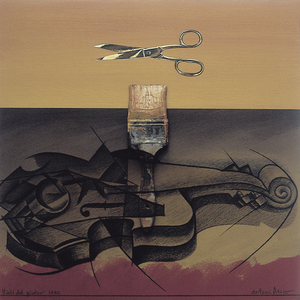Alfredo Torres
A miracle-worker of images
The task of devising a discerning prologue to approach the inaccessible profundity of images is always an arduous one. One fears an excessive unravelling of the essential image. Or the insufficiency of propitiating the communication ritual; particularly when one is speaking of atypical images, very different from the usual idioms. I remember a beautiful text written almost thirty years ago, but which nevertheless breathes enviable vividness today. The Spanish critic Vicente Aguilera Cerní claimed then: “Ours is a civilization of images: the invasion of images is produced technically (by means of technical emitters and technified procedures, as if trying also to make more technical perceptions, looking in them for the typical technical relation of equal cause, equal effect); we are in a consumer civilization which controls and technifies modes of perception to impose a rhythm of renovation and a certain quality on those proposals, images, messages or products that are to be consumed; we find ourselves immersed in vast processes of quantitative and qualitative massification”1. Those perceptive modes oscillate between dissimulated totalitarianism and total emptiness. The receiver, the spectator, becomes used to looking without seeing, to envision carelessly without allowing anything to sink in. Against all this, with the attitude of a recollector, a preserver, Antoni Miró configures his images.
The recollector of an ample panoply of images, but not only that. Basically he is like a taxonomist of unexpected classifications that he sorts with elegant precision, a miracle-worker who uses the most astounding associations, who orders, binds, organizes, and intertwines. Some theorists, preoccupied with a legitimate desire to apply a label, have linked the creation of Antoni Miró with the modern derivatives of Realism; such categorization is pertinent, undoubtedly, although it implies a certain simplification. He has also been associated with the iconic values of Neo-Pop or Neo-Figuration. Situating him thus is valid, but also limited. Personally, I find at times that his work has a tangential emanation of the only Surrealism still fertile: that of Duchamp. That emanation is perceived with greatest intensity in the series of etchings that poetize the bicycle. Or in the Magrittian strategies of mystery; not just those that explicitly refer to the brilliant Belgian artist as in the silkscreen “It is not a man” or the double contradiction of “La pipa” (The Pipe), but others also where the negation of evident citations produces a solemn absurdity, as in the etchings “No és Morandi” (It is not Morandi) or “No és Miró” (It is not Miró). In spite of all these probable links and others that could be established, the most surprising fact is that the play of citations, of astonishing crossbreeding, ends up producing a stylistic eclecticism that is his fingerprint, the certainty of his originality. “The weak, the anguished, feel strong when they run along together holding hands”2 Adorno said. The strength of Antoni Miró is not that of the ephemeral metropolitan flocks, it is not born of tied hands. With the lack of inhibition or lack of prejudice that only one with really free hands has, the artist, in an act of admirable rescue, appropriates bits and pieces of the ancient territory of artistic imagination. For instance, in an apparently calligraphic approach in the series of etchings called “Suite erotica” (Erotic Suite), he transposes the willowy characters of Greek urns. Or in a decidedly metaphoric approach, as in “Personatge”, where the tattered figures of the “Guernica” surround a very modern day Marx, who in spite of not being able to speak, or even to breathe, seems to be placidly alive.
Another outstanding trait in the images of Antoni Miró is the proposition of conflict, of the alternative, of the symbiotic relation between opposites. “Bicornis” (Two-horned) combines, with enormous efficacy, the hot primitivism of a rhinoceros with a diffuse landscape saturated with techno-industrial totems that tend to proliferate in urban peripheries. “Zebras-op” combines the lithographic sandiness of an orange background with the surprising, rhythmic geometricality unfolded by nature on the skin of beautiful animals. In a nearly photographic framing, “Xemeneies” (Chimneys) removes from context and nourishes with ambiguity the chimneys of Gaudí of “La casa Batlló” (Batlló house) in Barcelona; on a subsidiary ornamental object he superimposes the vigorous density of a sculptured form placed onstage almost with the intentionality of a ready-made graphic.
Thanks to this extremely vital image-confectioner, we can recuperate the capacity of looking slowly, with fruition, reflectively. We can dismantle this old encyclopaedic, and profoundly reactionary, paradigm that sensory pleasure, the almost luxurious delight of contemplation, has nothing to do with conceptual rigor, with analytic introspection. In the creative exercises of Antoni Miró, and fortunately in that of many others, art is again contaminated with the ups and downs of life-all the vicissitudes of life.
1. Vicente Aguilera Cerní: “El arte impugnado” Editorial Cuadernos para el Diálogo. Madrid, 1969.
2. Theodor Adorno: “Consignas”. Amorrorto editores. Buenos Aires, 1993.
